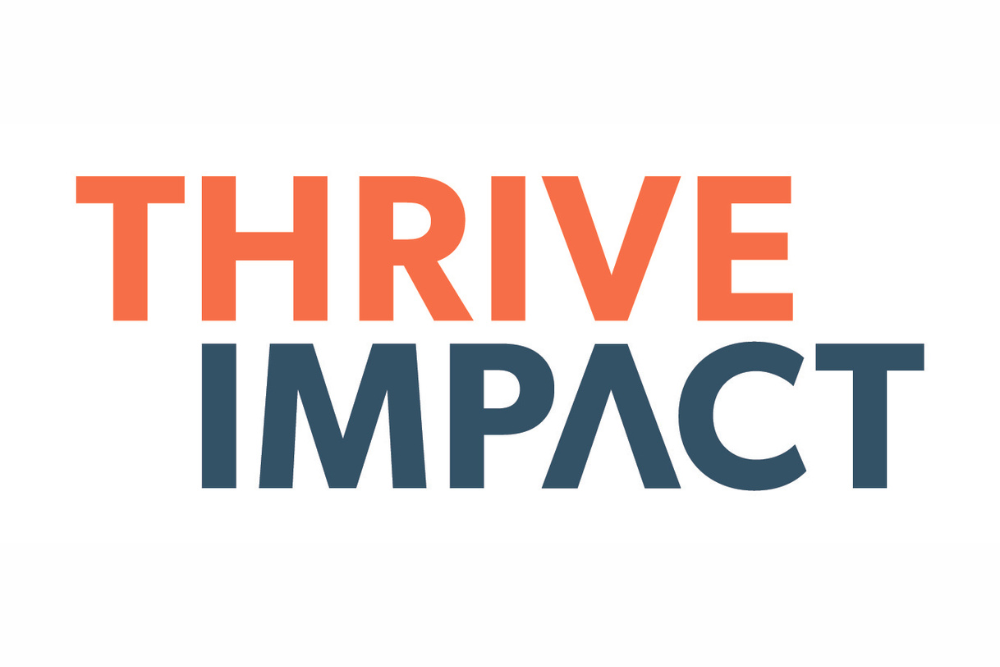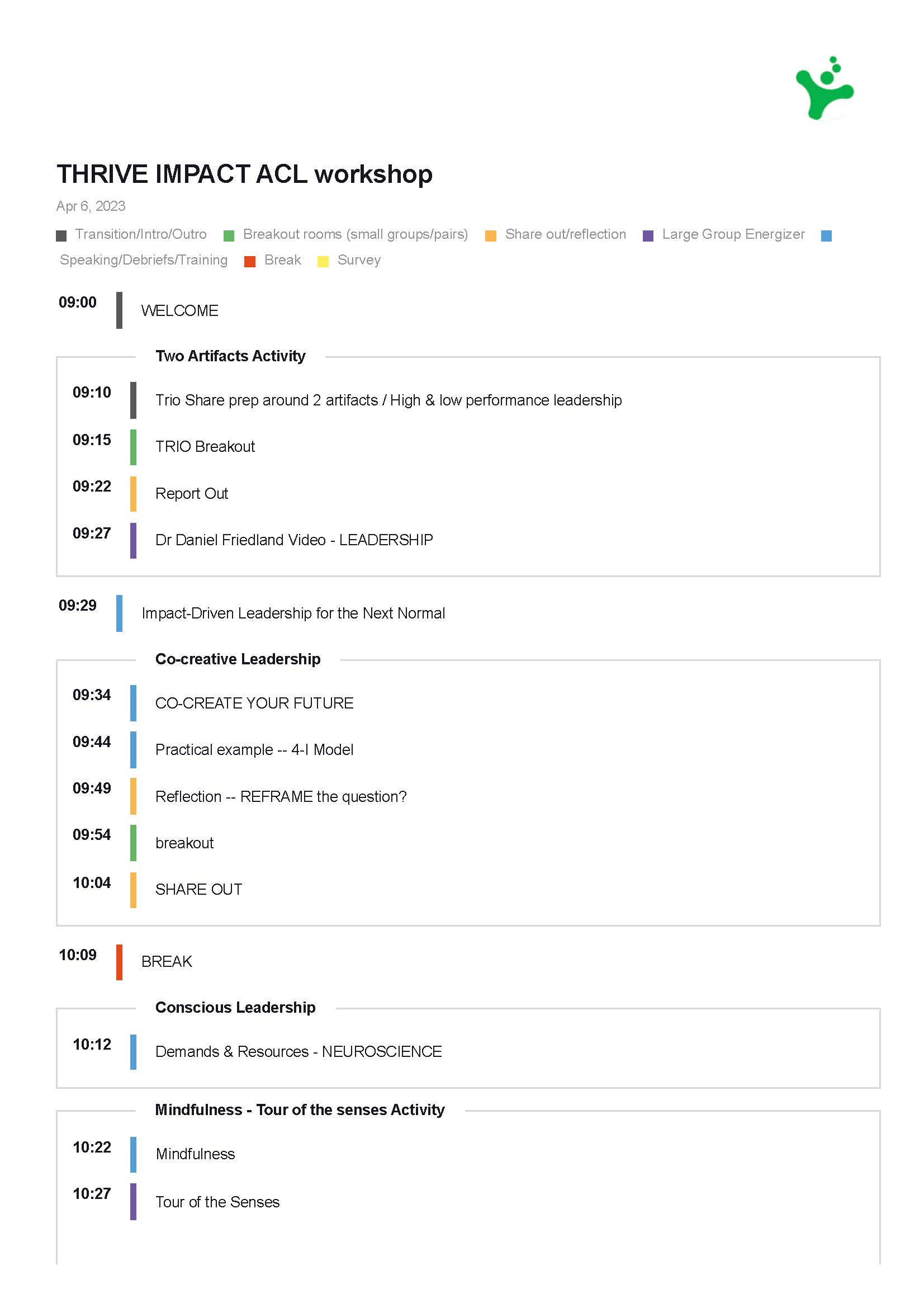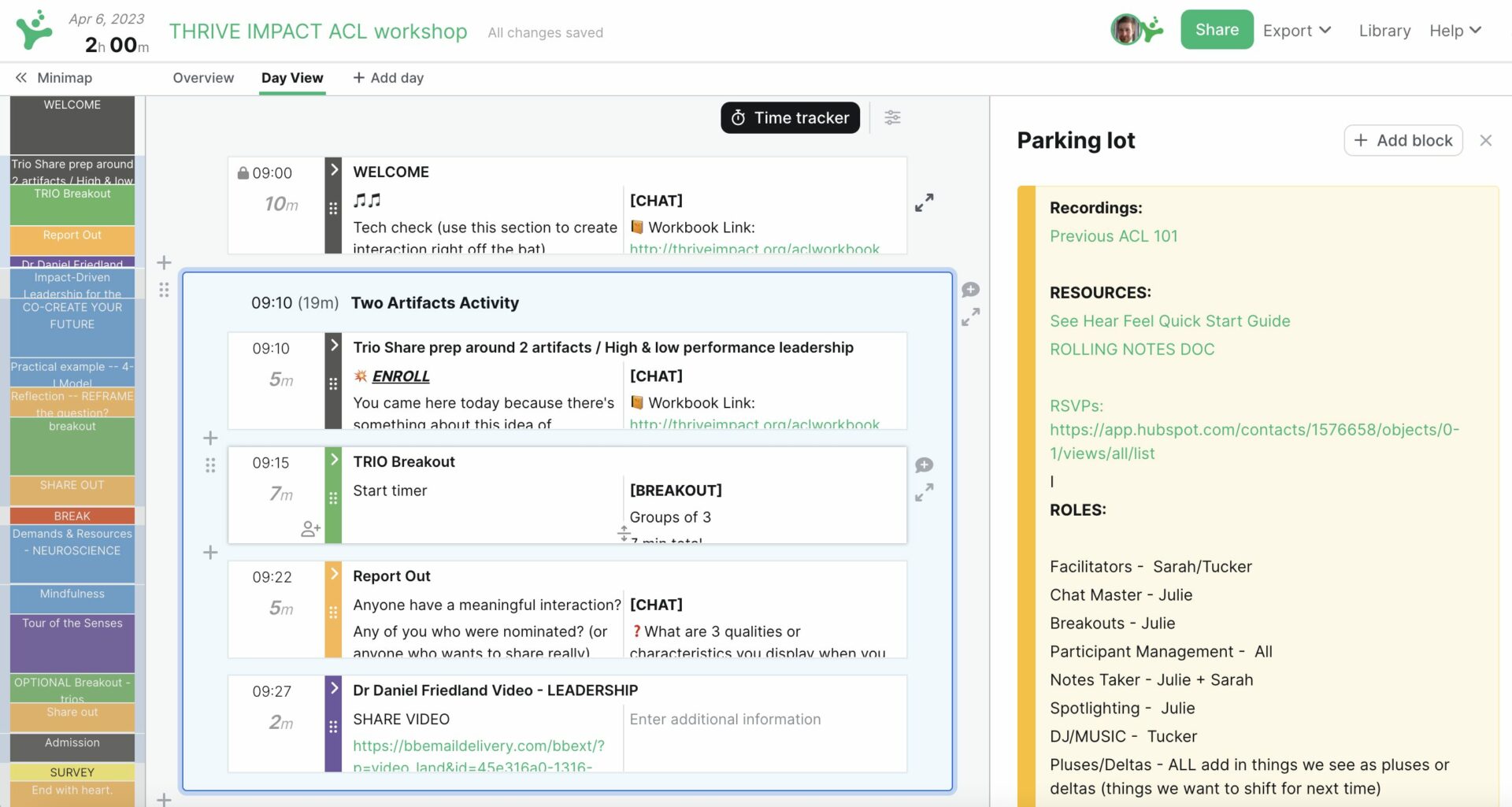How Thrive Impact uses SessionLab to help NGOs create sustainable change

Thrive Impact is an agency whose mission is to solve nonprofit leader burnout and enable NGOs to enact meaningful change. They’ve helped more than 50 organizations increase revenue, realize positive culture change and create sustainable impact.
CEO Tucker Wannamaker and the 10-person team at Thrive Impact use SessionLab to support their process and design the workshops and training sessions that form the foundation of much of the work they do. Let’s explore how SessionLab helps Tucker and his team create impactful learning experiences and save time in their design process.
Designing engaging learning flows
Whether it’s guiding a team through a strategic planning session or running NGO leadership training, the journey begins with a well-designed agenda.
While Tucker had previously used Excel to design his sessions, after using SessionLab, Tucker says he couldn’t go back.
“Excel is not a great tool for professional workshoppers designing a lot of experiences. I wondered what other agenda tools were out there and found SessionLab. I looked around in general and I thought oh, no, SessionLab. This is the agenda tool. We use it every day.”
For visual thinkers like Tucker, SessionLab’s simple overview and color coding is a massive boon to the workshop design process.
“I love the color coding because it helps us know what we’re looking for in all of our experiences. It lets me quickly see what each section of the workshop is doing at a glance.”
In SessionLab, you can flexibly color-code every block and instantly see a visual breakdown of your session in the mini-map. color code by activity type, learning style or whatever taxonomy suits your needs.

Tucker and the team at Thrive Impact use a standardized color scheme across their agendas to keep all their designers and co-facilitators on the same page.
“For example, green is for breakout rooms where participants are connecting with one another while yellow is for group sharing in the main room. Purple is a video or large group activity and blue is when a facilitator delivers content and training. Then we have red for a break or reflection.”
By color coding in this way, Tucker is able to easily see the ratio between different activity types and create a balanced and effective learning flow.
“We’re looking for a good ratio of green, purple and blues activities. If we have too much blue, that means we have too much content and we need to re-balance the agenda, because we already know based on the data around learning experiences that people don’t always learn well that way.”
For Tucker, well-designed and balanced experiences are the foundation of an effective workshop, especially when working in a virtual environment. By using SessionLab, the team is able to quickly create sessions that engage their clients in a spirit of co-creation and problem solving.
Effective co-creation
Effective collaboration and team alignment is a key aspect of any successful NGO. Similarly, Tucker and his team use SessionLab to co-create their agendas and collaborate on the design together in one-place.
“We all pull up Session Lab and go through the agenda at the same time. We start with a high level overview of where we’re going and then go down to the nitty gritty details.”

Once a high-level design is agreed upon, the team at Thrive Impact will assign each team member to the section or block they’re delivering so each facilitator can work on their script or content and easily get feedback from colleagues.
At the top of each agenda, they’ll add a note with important links and team roles to ensure everyone is aligned going into the session. With everything they need in one-place, Tucker and his team are able to deliver exceptional learning experiences, every time.
Creating a repeatable, systematized process in SessionLab has also helped the team streamline their workflow, save time and focus on what matters most.
“We have people on our team who love to systemize the process in SessionLab and it’s immensely important because it saves so much time.”
A big part of this process is about institutionalizing knowledge and making previous agendas and activities available to the team.
Not only does using templates and a team library help the team at Thrive save time, but it also helps them transfer knowledge and train new members effectively.
“With our SessionLab library, we can go in and say, oh yeah, I need to do that paired interview. Let me drag and pull that into my agenda and then I can make it my own. We can say, hey, go into the templates and take a look. That kind of internal collaboration and institutionalization is great.”
Supporting session delivery
When Tucker first started using SessionLab, what stuck out to him most was the ability to stay in control of time and dynamically update session timing during a workshop.
“The thing that was initially really helpful was the fact that you could have dynamic time in SessionLab. There are many times in the room where we actually add time as we go. So we’re like, wow, this section went way over and we’ll add extra minutes and adjust activities directly.”
In SessionLab, every block has a set time allocation. When you make changes in real-time, your total time and schedule will update automatically, giving you the confidence to make changes and see the impact on the rest of your agenda.

Tucker is also able to understand how he’s performing against schedule and make informed decisions on what to change while facilitating.
“We know in real time where the train is on the track from a schedule perspective. That’s an important benefit of using SessionLab for us, too.”
Time-locks have also been useful to the team at Thrive Impact. By locking time sensitive items in place, they’re able to ensure that there’s time left for reflection or breaks and that they cover everything needed.
“We always put a time lock at the very end of a session for five minutes. We know we always want to end a session with heart, which is really ending with space for reflection. Time-locking blocks gives me a good sense of how long I have.”
Conclusion
When NGOs are given the tools to plan strategically, reduce burnout and solve core problems, they can create impactful and lasting change.
For the team at Thrive Impact, that change all starts with a balanced and engaging session design. SessionLab plays a part in helping Tucker and the team design effective learning experiences and help NGOs achieve their goals and make change in the world.
“We love SessionLab. We run so many workshops that we literally use it, almost every business day.”



Leave a Comment